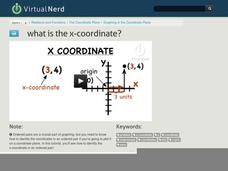Brian McLogan
What is the definition of the inverse Tangent function
👉 Learn how to evaluate inverse trigonometric functions. The inverse trigonometric functions are used to obtain theta, the angle which yielded the trigonometric function value. It is usually helpful to use the calculator to calculate the...
Brian McLogan
Learn how to solve a simple trig equation
👉 Learn how to solve trigonometric equations. There are various methods that can be used to evaluate trigonometric identities, they include by factoring out the GCF and simplifying the factored equation. Another method is to use a...
Brian McLogan
Master how to determine if a graph is a function or not
Master how to determine if a graph is a function or not
Brian McLogan
What is the slope formula and where does it come from
👉 Learn all about the slope of a line. The slope of a line is the steepness of the line. The horizontal line has a zero slope while the vertical line has an undefined slope. To determine the slope of a line, we need to know the...
Brian McLogan
Identify the slope between two points using the slope formula
👉 Learn how to find the slope between two points. The slope of a line is the steepness of the line. The horizontal line has a zero slope while the vertical line has an undefined slope. To determine the slope of a line passing through two...
Brian McLogan
Define Function, Function Notation, Domain and Range
Define Function, Function Notation, Domain and Range
Brian McLogan
Find the slope of a line given graph
👉 Learn how to find the rate of change from graph. The rate of change is the rate at which y-values are changing with respect to the change in x-values. To determine the rate of change from a graph, a right triangle is drawn on the graph...
Brian McLogan
What is the parent function of a linear graph
👉 Learn about graphing linear equations. A linear equation is an equation whose highest exponent on its variable(s) is 1. i.e. linear equations has no exponents on their variables. The graph of a linear equation is a straight line. To...
Brian McLogan
Where do the basic trigonometric identities come from
👉 Learn all about the different trigonometric identities and how they can be used to evaluate, verify, simplify and solve trigonometric equations. The identities discussed in this playlist will involve the quotient, reciprocal,...
Curated OER
What is the Y-Coordinate?
How are ordered pairs, coordinate points, and graphing related to each other. What is the importance of the y-coordinate? Does it matter what order you write an ordered pair in? Yes! The y-coordinate is always written second. Always! And...
Curated OER
What is the X-Coordinate?
How are ordered pairs, coordinate points, and graphing related to each other? What is the importance of the x-coordinate? Does it matter what order you write an ordered pair in? Yes! The x-coordinate is always written first. Always! And...
Curated OER
What Is the Distance Formula?
Find the distance between two points on a coordinate plane. How is that done? Let's take a look at the distance formula. What's the distance formula? Well, it's a form of the Pythagorean Theorem. How? Watch the instructor diagram and...
Curated OER
How Do You Use a Scatter Plot to Find a Line of Fit?
What is a line-of-fit? Given a data set, plot the ordered pairs on a graph. It looks like a scatter plot. Now estimate, and draw a line that best fits what the data represents. That is your line-of-fit.
Curated OER
How Do You Use a Scatter Plot to Find a Line of Fit?
What is a line-of-fit? Given a data set, plot the ordered pairs on a graph. It looks like a scatter plot. Now estimate, and draw a line that best fits what the data represents. That is your line-of-fit.
Loyola University Chicago
Math Flix: Tranformations Coordinate Plane 2 Flip, Slide
This QuickTime movie provides an opportunity to look at what graphing a transformation looks line on the coordinate plane. As you watch and listen to the teacher and student interact it helps clarify the thinking behind applying this...
Sophia Learning
Sophia: Finding the Domain of a Root Equation: Lesson 4
This lesson demonstrates how to find the domain of an equation that has a root. It is 4 of 8 in the series titled "Finding the Domain of a Root Equation."
Sophia Learning
Sophia: Finding the Domain of a Root Equation: Lesson 1
This lesson demonstrates how to find the domain of an equation that has a root. It is 1 of 8 in the series titled "Finding the Domain of a Root Equation."
Sophia Learning
Sophia: Finding the Range of an Exponential Equation: Lesson 2
In this lesson, the procedure for determining the range of an equation with a variable in the exponent is shown. It is 2 of 8 in the series titled "Finding the Range of an Exponential Equation."
Sophia Learning
Sophia: Finding the Range of an Exponential Equation: Lesson 4
In this lesson, the procedure for determining the range of an equation with a variable in the exponent is shown. It is 4 of 8 in the series titled "Finding the Range of an Exponential Equation." Includes short quiz. [2:40]
Sophia Learning
Sophia: Finding the Range of an Exponential Equation: Lesson 5
In this lesson, the procedure for determining the range of an equation with a variable in the exponent is shown. It is 5 of 8 in the series titled "Finding the Range of an Exponential Equation."
Sophia Learning
Sophia: Finding the Range of an Exponential Equation: Lesson 7
In this lesson, the procedure for determining the range of an equation with a variable in the exponent is shown. It is 7 of 8 in the series titled "Finding the Range of an Exponential Equation."
Sophia Learning
Sophia: Finding the Range of an Exponential Equation: Lesson 1
In this lesson, the procedure for determining the range of an equation with a variable in the exponent is shown. It is 1 of 8 in the series titled "Finding the Range of an Exponential Equation."
Sophia Learning
Sophia: Finding the Domain of a Root Equation: Lesson 3
This lesson demonstrates how to find the domain of an equation that has a root. It is 3 of 8 in the series titled "Finding the Domain of a Root Equation."














